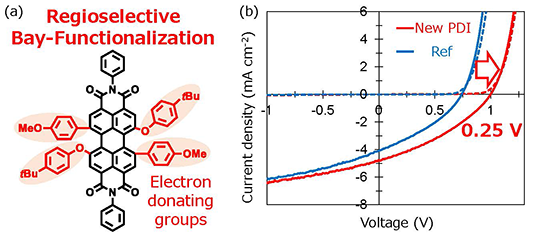Researchers at Institute for Molecular Science and Shizuoka University in Japan report that regioselective bay-functionalization of perylene derivatives and the use of the synthesized perylene diimide (PDI) as an acceptor material reduces the open-circuit voltage loss in organic solar cells (OSCs). The origin of the high VOC was that bay-functionalization liftes LUMO level, leading to the reduction of the energy offset for charge separation and non-radiative recombination loss.
The power conversion efficiencies of organic solar cells (OSCs) based on blends of electron donor (D) and acceptor (A) semiconducting materials now exceed 16%. However, it is still lower than that of highly efficient inorganic SCs such as GaAs and perovskite. The charge generation efficiency in OSCs nowadays is nearly 100%, thus reducing the energy loss in output voltage is critically important for further enhancing the efficiency of OSCs.
Group of Assistant Professor Seiichiro Izawa and Professor Masahiro Hiramoto at Institute for Molecular Science and Professor Masaki Takahashi and Assistant Professor Keisuke Fujimoto at Shizuoka University in Japan report that regioselective bay-functionalization of perylene derivatives and the use of the synthesized PDI as an acceptor material reduces the open-circuit voltage loss in OSCs. PDI, a promising candidate as a superior non-fullerene acceptor material for OSCs, has attracted tremendous attention due to the highly efficient charge-carrier properties. However, it has been still difficult to synthesize custom-designed PDIs with high efficiency and desired regioselectivity. Reserchers developed regioselective bay-functionalization of PDI by using their original synthetic protocol of highly controllable monobromination of peryrene tetracarboxylate. The bay functionalization by electron donating groups lifted LUMO level of synthesized tetrasubstituted PDI (Fig. 1a). The use of the synthesized compound as an acceptor material of OSC increased open-circuit voltage as 0.25 V than non-substituted PDI (Fig. 1b). The origin of the high VOC was that bay-functionalization liftes LUMO level, leading to the reduction of the energy offset for charge separation and non-radiative recombination loss that is the most important topic in OSC field nowadays. The results will open up new aveneues for future development of potential PDI-based acceptor materials through the tailor-made synthesis of bay-functionalized PDIs for efficient OSCs.

Fig. 1 (a) Chemical structure of tetrasubstituted PDI. (b) J-V curves of OSCs with tetrasubstituted PDI and reference compound.
Information of the paper:
Authors: Keisuke Fujimoto, Seiichiro Izawa,* Yusaku Arikai, Shinya Sugimoto, Hirona Oue, Toshiyasu Inuzuka, Naohiro Uemura, Masami Sakamoto, Masahiro Hiramoto and Masaki Takahashi*
Journal Name: ChemPlusChem, 85 285-293 (2020)
Journal Title: “Regioselective Bay-Functionalization of Perylenes Toward Tailor-Made Synthesis of Acceptor Materials for Organic Photovoltaics”
DOI:10.1002/cplu.201900725
Financial Supports:
Nanotechnology Platform Program (Molecule and Material Synthesis) and JSPS KAKENHI (Grant-in-Aid for Young Scientists) of the Ministery of Education, Culture, Sports, Science and Technology (MEXT), Japan and grants from the Ogasawara Foundation for the Promotion of Science & Engineering, the Takahashi Industrial and Economic Research Foundation, the Foundation of Chubu Science and Technology Center, and the Mazda Foundation.
Numbers:
18K14115
Contact Person:
Seiichiro Izawa
TEL/FAX: +81-564-59-5537 / +81-564-59-5537
E-mail: izawa_at_ims.ac.jp (Please replace the "_at_" with @)
1116
3451

